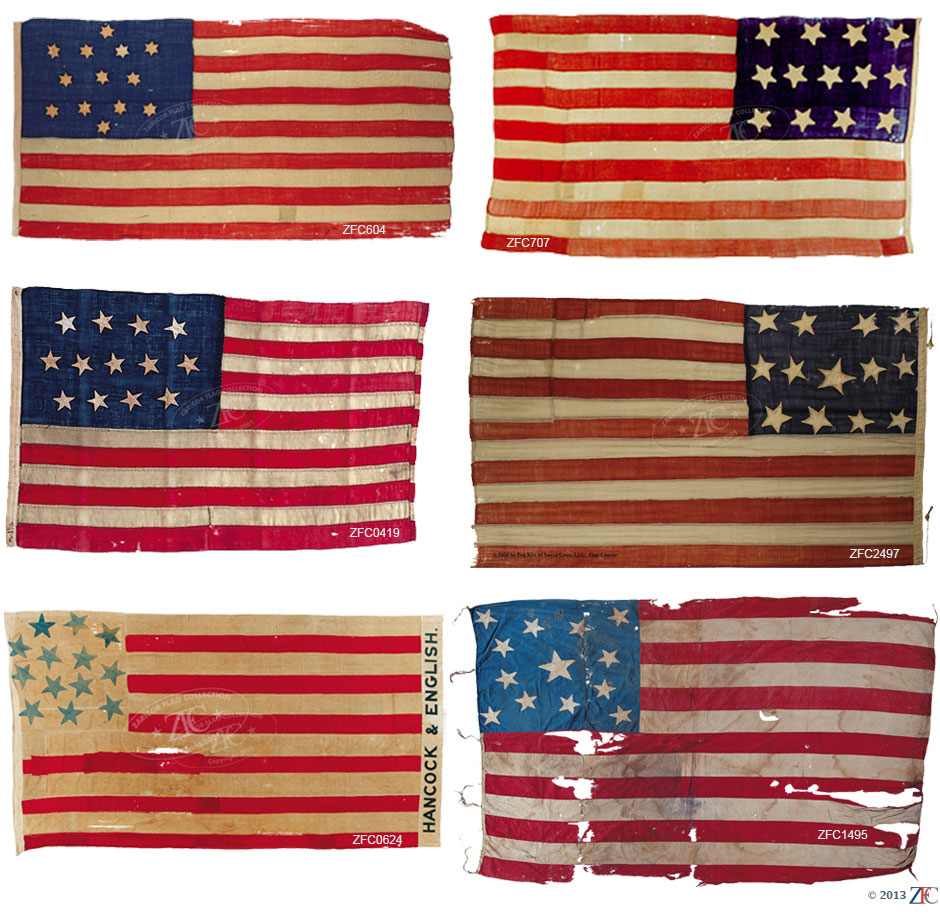01. First Flag Act 1777: 13 Stars, Revolution & Early Federal Period
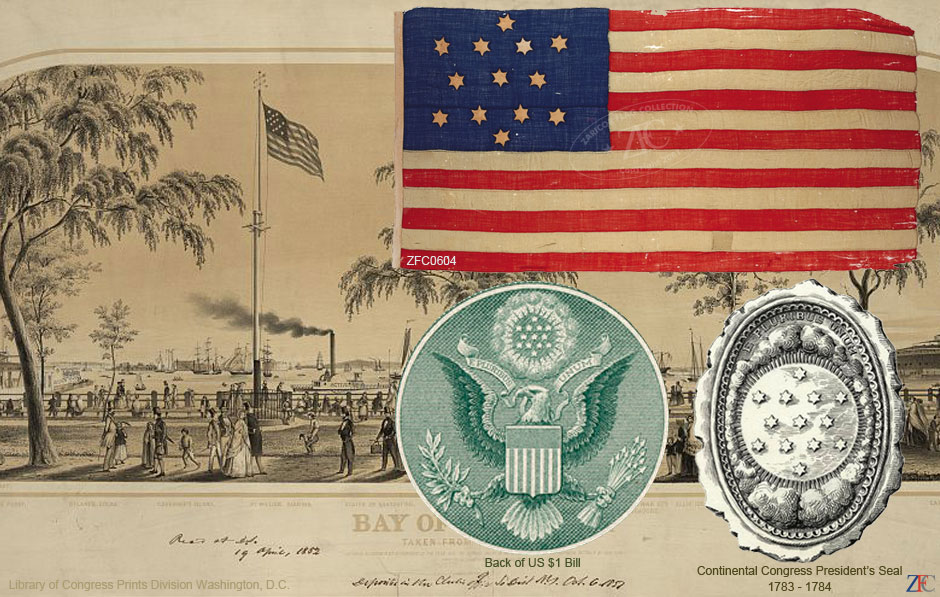
√?¬†
ZFC0604 United States 13 Star Flag - Great Star in Glory.
This 13-star Grand Luminary flag is made of wool bunting with six-point,√?¬†linen stars gracing the canton. These features point to early federal period origins, especially the six-pointed stars, which are a common feature of 18th century flags.
Today, we often incorrectly assume that a star means one of the fifty, traditional five- point stars we see on the present United States flag. In fact, a star may have many more meanings. In the early days of the republic, a star depicted or drawn as a representation of a heavenly body generally had six or more points. One with five-points was more correctly called a "mullet" and represented a stylized rowel of a spur. In the 18th century, flags commonly had six, seven and eight point stars. The five-point star became a more standardized feature after the passage of the Second Flag Act in 1795.
The six point stars on this flag are arranged in the form of a great six-pointed star representing a glory. A glory is a meteorological phenomenon wherein a halo or "false sun" appears opposite the sun. Often interpreted as some form of Divinity or Providential Acquiescence, glories are formed by vaporized scatterings from cloud or mist droplets. They commonly appear on mountains and hillsides when the sun breaks through mist and when there is an opportunity to look downwards towards the anti-solar point.
This flag was originally constructed entirely by hand; however, there are also areas of machine sewing, which cannot have occurred prior to 1847. However, these repairs are indications of the high regard in which this flag was once held, and still is today. Part of its early history has been discovered. It was acquired at Sotheby's Auction of the Mastai Estate Flag Collection in New York City on October 10, 2002, as Lot No. 9; however, it was not a Mastai flag but a related piece offered in conjunction with that sale.
Research reveals it to be from the Society for the Preservation of Long Island Antiquities collections. According to their records, a period 13-star flag was donated to them in 1966 by the Youngs family, but was subsequently withdrawn, possibly because the machine stitching reduced the likelihood of it being a period flag. Unknown to the person or persons who made the decision to withdraw the flag; the machine stitching, which is clearly seen in the field of the flag by textile examination, revealed that the machine stitching was not the original thread on the flag. Analysis revealed the original thread was hand sewn silk thread. The use of silk thread along with examination of all the materials the flag was made from, including the construction method, reveal that they are of 18th century origin.
This flag was made sometime between 1782 and 1790, likely right after the return of NY to the colonies when the British left and the new American government was formed. Because of the hexagram's simple geometry, symmetric appearance and functionality - it is easy to draw - it has been a popular symbol from ancient times. It has a long and complex history, and was often used to indicate the combination of terrestrial and celestial realms. It is the most iconic symbol of Judaism today. Known as the "Magen David", or Shield of David, it graces the current flag of the State of Israel but the motif, was not originally Jewish. In the ancient world, hexagrams were used by many religions, and in the Dark Ages, Jews, Christians, and Muslims alike used them as auspicious symbols.
U.S. government versions of the Great Seal show the constellation of 13 stars in a hexagram pattern of two triangles intersecting to form a six-pointed star. There has been much speculation about the symbolic intent of this hexagram, but it may simply be a rearrangement of the 3-2-3-2-3 star pattern on early United States flags.
The large six pointed star formed from 13 smaller stars has been a distinctive feature of the U.S. Arms and Great Seal since 1782. This early Federal Period flag incorporates this design motif into its canton. This flag is unique as it was used during the 21 months New York City served as our nation's capital (March 4, 1789 to December 5, 1790) and perhaps sometime before.
The Great Seal of the United States was approved on June 20, 1782. Charles Thompson, the seal's designer and Secretary of the Congress, first described the blazon or heraldic description for the crest, which appears above the head of the American bald eagle, but no official arrangement for the stars was specified.
Curiously, a flag with this same star field pattern is depicted in an 1851 lithograph "The Bay of New York" taken from the Battery by Edward Valois. Believed to depict the 4th of July, it is thought that it may depict this very same flag, flown in commemoration on that holiday and explains why the flag was repaired with machine stitching; so that it may be used on that auspicious day, the 4th of July.
Although this is conjecture, circumstantial facts support the theory: the original flag is from the period; it was lovingly repaired for reasons now lost to history; it was retained by a prominent Long Island historical association; this variant star pattern of the Grand Luminary is almost unknown in the 19th century and this may have been a 4th of July commemoration of the events of Evacuation Day 1783, when a United States flag replaced the Union Flag of Britain at Battery Park in New York City.
The pattern is so rare that this is the only one of size to fly that has ever been seen by flag collectors. Replicas of this pattern and flag with 5 pointed stars are known to exist, dating from the centennial period 1876 which suggests that the five pointed stars are a result of exact specifications for the original flag which were subsequently forgotten or lost to the flag makers of the miniature replicas in 1876. In fact it is believed by this collector that only one of these flags was made in the 1780s, because it is closely associated with the President of the Continental Congress whose shield depicts this very design in 1782. Such usage would also explain how a flag of 68 years would still be in condition to fly in 1851 at the Battery for a limited time because it was used indoors and protected from the elements. Likewise, we have flown flags much older (173, 168 and 142 years old for example), some were even used outdoors during the Civil War; they withstood the event well with no damage and were a sight to experience. Such an example was a flag of 142 years when Tom Lecky and Ronald Varney flew the flag December 2012 (ask them to show the photos!).
This flag is truly a national treasure that, through commitment to uncover the history of flags once thought lost to the past, survives to tell us more about the American experience and character. It is one of the most important flags in the country.
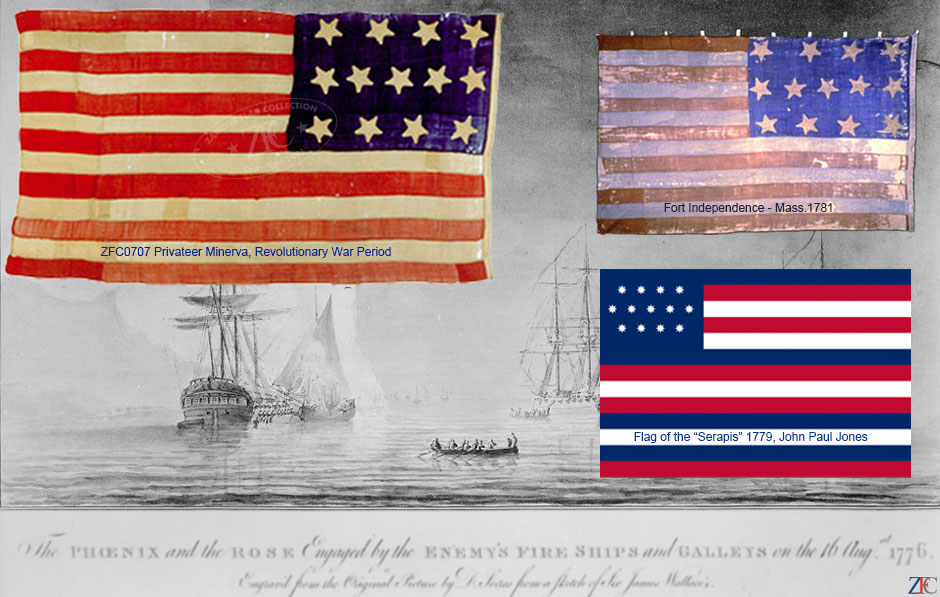
ZFC0707 - United States 13-Stars flag - Privateer Minerva.
This is the hand-sewn ensign from the Revolutionary Privateer Minerva and is believed to be the only named ensign to have survived. It was formerly part of the acclaimed collection of noted antique dealer Mr. Boleslaw Mastai and his wife Marie-Louise D'Otrange Mastai.
This star pattern was favored by some of the ships of war of the Continental Navy, privateers and merchant ships at the time of the American Revolution. It was favored because the straight horizontal lines made interpreting the nationality of the flag hence the ship much easier to recognize its nationality. For this reason the horizontal star pattern gained favor over many other patterns used on land. It was not uncommon for coastal forts and light houses to also use this 4-5-4 pattern. Therefore, in the ZFC collection there are other such examples. The flag that is displayed with ZFC0707 in the graphic above is the Ft. Independence Flag, a well-known Revolutionary War fort located in Massachusetts. (Note: The Ft. Independence Flag was on display in the Capital Building Rotunda in Boston for many decades. It is very interesting to compare the Ft. Independence Flag to the Minerva flag. Contemplating closely the orientation of the individual stars on both flags, one notes that they are all oriented identically except for three of the stars and, in that case, two of the different orientations are in the same location on the flag. It is our opinion that this suggests there was a specific regulation that they be oriented the same way or both flags were made by the same flag maker. It is improbable that it was by coincidence that two different flag makers would use the same orientation. This hard evidence is very rare to find and has only happened a handful of times in working with our collection which involves thousands of artifacts.)
According to Mastai this was an early Stars & Stripes from the famed privateer. The 13 Colonies, having declared their Independence, had only 31 ships comprising the Continental Navy. To add to this, they issued "Letters of Marque" to privately owned, armed merchant ships and commissions for privateers, which were outfitted as warships to prey on enemy merchant ships.
In late July of 1781, the British merchant ship Hannah was seized and brought into New London by the Minerva, captained by Dudley Saltonstall. She was the largest prize taken during the entire war, with a cargo of West Indian goods, gunpowder and personal supplies and baggage for the British officers stationed in New York City. The value was estimated at 80,000 pounds sterling.
Dudly Saltonstall (1738-1796) was a Boston captain, merchant, and privateersman in the French and Indian War. He became the 4th ranking Captain in the Continental Navy in the Revolutionary War in 1775, and was given command of the Alfred, Commodore Esek Hopkins' flagship which successfully raided New Providence in the Bahamas for cannon. In 1779 he was made Commodore of the Penobscot Expedition, which ended in a disaster for which he was blamed and dismissed from the Navy. He then turned profitably to privateering.
The loss of the Hannah spurred the British to retaliate. To punish New London for its success at privateering it was mercilessly attacked by troops lead by the traitor Benedict Arnold, who had been born and raised only 10 miles away, in Norwich, and was anxious for a command and to demonstrate his newfound loyalty to King George III.
After the Revolutionary War this flag passed to a shipmate and friend of Saltonstall's, Captain John Spear who preserved it. Mastai acquired and identified this flag, exhibiting it at least twice: in 1973 at the Amon Carter Museum in Fort Worth Texas, and in 1978 at Building 6, World Trade Center, New York City.
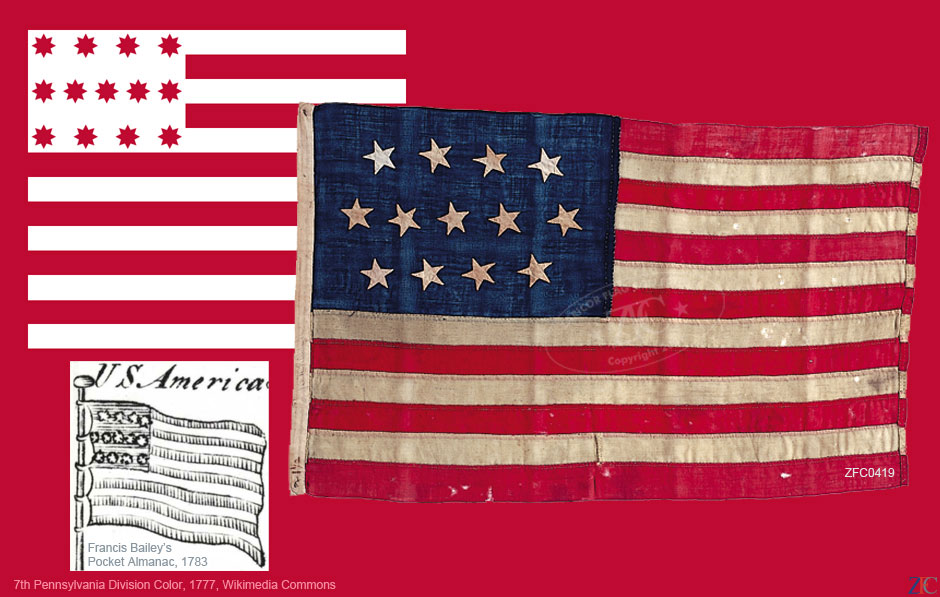
ZFC0419 - 13-Star United States Merchant Ensign, 4-5-4 Star design, Early Federal Period.
The early history of this flag is unknown, but it originates from the personal collection of noted collector William H. Guthman, founder of Guthman Americana in Westport, Connecticut where he was a respected dealer, scholar and author, and was considered a preeminent authority on Colonial and Federal period militaria.
Bill Guthman, an American-history buff since his youth, became interested in military antiques in 1966 from his profession as a textile-manufacturing executive. As a prominent antiques dealer he came to specialize in historical military Americana and helped make them noticed in the collecting world. Mr. Guthman collected artifacts of the French, Indian and American Revolutionary Wars; and was one of the very first individuals to consider militaria as folk art.
There is probably no other 13-star American flag better known to the general public than the "Betsy Ross design" with its 13 red and white stripes and single ring of 13, white 5-point stars. Historians today think that most such flags date from the years 1777-1795, when the 13-star flag was official had rows of stars and not constellations. The reason for this, on sewn flags, was largely practical. It is easier to sew stars onto flags in rows rather than geometric shapes. The five point star is easier to make and easier to see. Evidenced by surviving examples and period illustrations documenting 18th century arrangement for the stars in the United States flag, the 4-5-4 star pattern is both one of the first and one of the most common designs.
Both stars and stripes stood for the 13 original states - Delaware, Pennsylvania, New Jersey, Georgia, Connecticut, Massachusetts, Maryland, South Carolina, New Hampshire, Virginia, New York, North Carolina and Rhode Island. During the administration of President Thomas Jefferson (1801-1809) the United States purchased the Louisiana Territory from France. The Lewis and Clark Expedition during those years laid the basis for later American claims to sovereignty in the West.
This flag may well be one of the earliest United States flags in the Zaricor Flag Collection. While the use of cotton stars suggests to some production after 1800; recent scholarship indicates both the presence and use of cotton threads prior to 1793. Recent textile analysis suggests this flag is contemporary of the revolution period (circa 1800). The woolen stripes have selvedges typical of early hand-loomed material and the flag is hand-stitched. The finishing details indicate that a professional manufacturer made this flag, e.g. the finely crafted linen hand whipped-stitched eyelets on the hoist. Interestingly, the marking on the flags cotton heading refers to a flag manufactured to specific fly dimensions; in this case one and a half yards or 54". As a result of extensive usage, the fly has been trimmed and sewn again and is now only 48". The sizeable marking on the heading is more typical of flags manufactured as stock items rather than individually handcrafted on special order. One of the earliest identified flag manufacturers in the United States was Rebecca Young of Philadelphia and Baltimore. She advertised in the newspapers around 1803 that she had ready-made flags. This flag might well be one of her products.
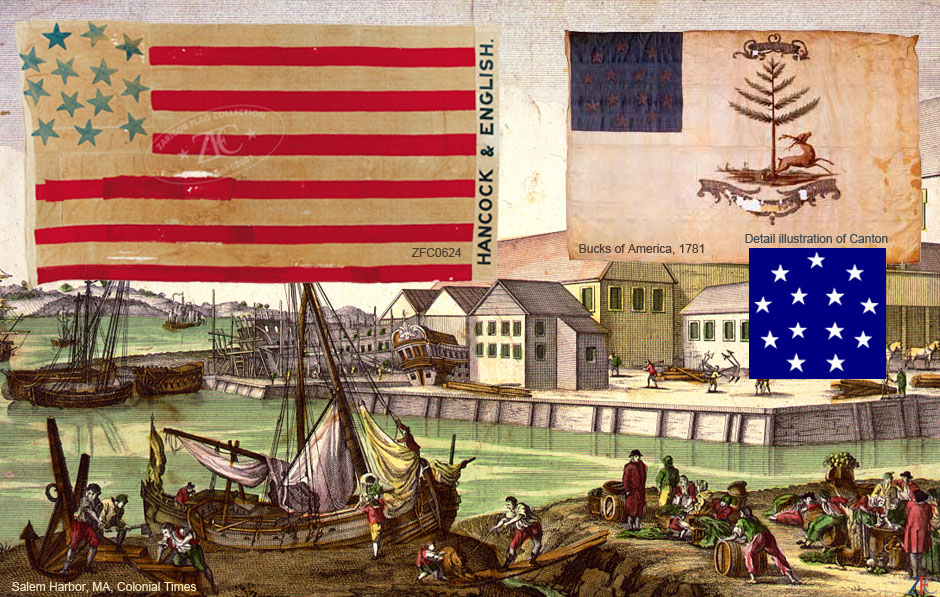
ZFC0624 United States 13 Star Flag - Salem Massachusetts
This period thirteen star flag from Salem, MA early history is unknown; but it was formerly part of the acclaimed collection of noted antique dealer Mr. Boleslaw Mastai and his wife Marie-Louise d'Otrange Mastai, formerly of New York City, and later Amagansett, Long Island. Their collection was the result of fifty years of collecting, research and study by the late husband-wife team. Mastai, started collecting in the early 20th century and amassed the greatest private flag collection in the United States; which he detailed in his landmark book The Stars and The Stripes; The American Flag from Birth of the Republic to the Present , published by Alfred Knopf, New York 1973; and hailed as a reimagining of the American Flag as both folk art and as social history.
This is a very rare period 13 star flag. Mastai was a very deliberate scholar, and selected this flag as Mastai #1 in his collection, reinforcing the high opinion he had of this flag. Also, it was this flag that he and his wife chose to be photographed holding for the end paper of the book jacket of the aforementioned book. Further, he selected this flag to be featured on the 7 July, 1980 cover of Time magazine after exhibiting it at least twice in 1973 at the Amon Carter Museum in Fort Worth Texas, and in 1978 at Building 6, World Trade Center, New York City.
Period illustrations from the 1780s indicate that the 13 stars of the United States flag were occasionally arranged as a circle of 13 or less stars arranged around the remaining stars. Furthermore, while this suggests that circular patterns were in the public minds in the 18th century actual specimens are quite rare. Similarly, other images indicate that there was little uniformity in the construction and use of early flags; this has given rise to many various interpretations to explain these differences. One common assumption is that militia troops generally carried non-standard or variant flags with blue or red stars and stripes of various colors. This seems to stem chiefly from the oral history asserting that a surviving flag with 13 blue stars on white was displayed by North Carolina militia at the Battle of Guilford Courthouse on March 15, 1781. There are also some examples of civilian use in the last quarter of the 18th century but such motifs occurred very rarely and were almost non-existent in the early 19th century until the practice disappeared in the 1840's.
This star pattern, the single ring of nine with four center stars, is identical to the canton on the flag of the Bucks of America (see photo and information in this section). A Massachusetts militia unit composed of freemen of color were presented this flag in the late 1780's. While circumstantial, it supports the use of this motif during the revolutionary era; a 13 star design literally unknown at any other time in American history. The number nine was an auspicious number in this era.
It is interesting to note that the two flags were made and used in New England during the early Federal period. Both can be dated to the late 1780's; one is military and the other is civilian with the single ring of nine stars with four center stars. Whether this was a coincidence or intentional remains unknown given, however, that the number "nine" was an auspicious number in the late 18th century, it has been speculated this may have been a code for some unknown purpose. There is another flag in the Collection (ZFC0605) that has a very similar design with 10 stars making a circle and three stars in the center. It was said to have been made for the 1876 Centennial - which raises our interest. Such flags made for the Centennial had a specific reason or purpose; yet an answer has remained elusive.
The North Briton, a radical weekly publication printed in Great Britain, issued number 45, on April 23, 1763. This is the most famous issue of the paper. In it John Wilkes, a British politician, criticized a royal speech of King George III. Wilkes was charged with seditious libel (for accusing the king of lying), and imprisoned for a short time in the Tower of London. Wilkes challenged the general warrant for his arrest and seizure of his paper, eventually winning the case. His courtroom speeches launched the cry "Wilkes, Liberty and Number "45" a popular slogan for freedom of speech and resistance to power. As a result, "45" had become a popular icon not only of Wilkes, but of liberty and freedom of speech in general. This was shortened to "9" (4+5=9), and the numeral "9" became associated with free speech and radical, liberal causes in the 18th century.
In 1767, the Sons of Liberty utilized a flag called the "rebellious stripes flag" with nine uneven vertical stripes (five red and four white). The nine stripes represented the number of colonies that attended the Stamp Act Congress and were symbolic of "45" the pamphlet published in 1763 by the civil-rights activist John Wilkes, whose influence on the American revolutionary movement was second only to Tom Paine's "Common Sense." Later, the symbolism of "9" came to represent the nine states needed to approve the Constitution on September 17, 1787: although Benjamin Franklin had urged unanimity, the Congress decided they only needed nine states to ratify the constitution for it to go into effect. Once the Congress of the Confederation received word of New Hampshire's ratification, on June 21, 1788, it set a timetable for the start of operations under the Constitution, and on March 4, 1789, the government under the Constitution began operations - and so "9" came to also represent the nine states which ratified the union into existence.
The use of the single ring of nine stars is a symbolic design element that would have been immediately understood the late Colonial, Revolutionary and early Federal Period. Considering the flag from its construction elements and discounting 19th & 20th century repairs and additions, the original portions of this flag contain nothing that would exclude it from being a product of the 18th century. The presence of cotton thread is not a disqualification, as recent scholarship has demonstrated the use of cotton in the 1760's and the fabrication of cotton sewing thread in New England as early as the 1790s. The numerous repairs and remakes also attest to the importance placed upon this flag by subsequent owners.
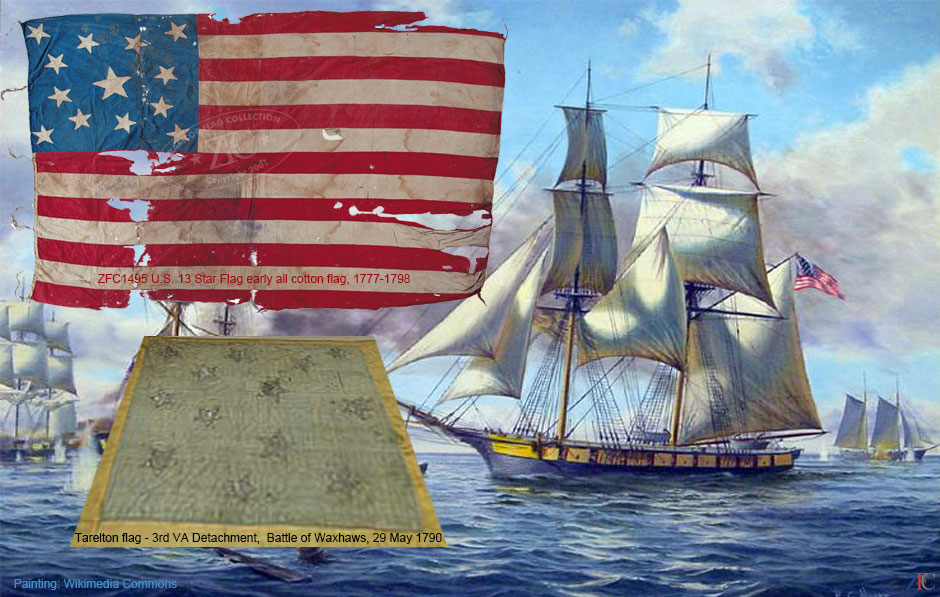
ZFC1495 - United States 13-Star Flag - early all cotton flag, naval or maritime.
While first sold at an auction as a 13-star ship's flag from the American Revolution period 1777-1783, in fact, upon examination by a textile expert it was concluded that the materials were all available in the 18th century and the construction techniques used can be dated to the 18th century. Further research revealed that another flag in the ZFC collection ZFC0423, an all-cotton 16-star flag, shared many characteristics with this flag suggesting that the same Philadelphia-based maker may have manufactured both flags. Since this particular flag had no provenance when purchased it is important to consider its sister 16-star flag's provenance for clues which might help to accurately date it.
This flag bears several remarkable similarities to the previously mentioned 16-star flag also contained in the ZFC collection. Both flags evidence similar production techniques: they are made entirely of cotton; arrange their stars in a circular fashion around a larger central star; they have relatively small cantons resting on a red stripe and they use the method of attaching the flag to a staff or halyard by way of a number of metal rings sewn to the cotton heading. In addition, since the sixteen-star flag is sewn with a thread that has been dated to no earlier than 1840, it is likely that this flag dates from the same decade. At least two militia flags made during the War with Mexico also display their stars in a circle around a central star, indicating that this flag may date from the same period.
The 16 star flag ZFC0423 provenance is well documented as having been the property of the Vaux family, a notable family in Philadelphia during the 18th and 19th centuries. Records indicate that the flag was gifted to the Academy of Natural Science in Philadelphia in 1812, testifying that the flag was constructed in the late 18th century or the early 19th century - no later than 1803 when a 17th star was added to the national flag (though unofficially as the 15-star flag was the official flag at that time). It was customary, however, to add a star for each new state throughout the duration of officially 15-star flags. The flag eventually ended up in the Star Spangled Banner Collection in the early part of the 20th century.
Another significant feature of the 16-star flag in relation to this flag is the use of cotton. It proves that early US flags were sometimes made of cotton which at that time would have been a luxury - this period preceded the advent of the cotton gin which made the material a cheap commodity. Making a flag out of cotton during this period would have been a statement, e.g. the use of an expensive, durable fabric for an important symbol such as the country's flag.
This 13-star flag warrants further study and analysis because new research conducted after the flag's exhibition in San Francisco indicates that this star pattern potentially dates back to the revolution - when one of the flags captured by the British cavalry officer Banastre Tarleton had this pattern of stars on one of three flags captured at the Battle of Waxhaws, South Carolina 1780. Therefore, what we currently believe to be a flag from the 1840s in fact has attributes which possibly place it as far back as the late 1700s, making it a unique original 13-star flag from the Federalist period and possibly the Revolution against Great Britain.
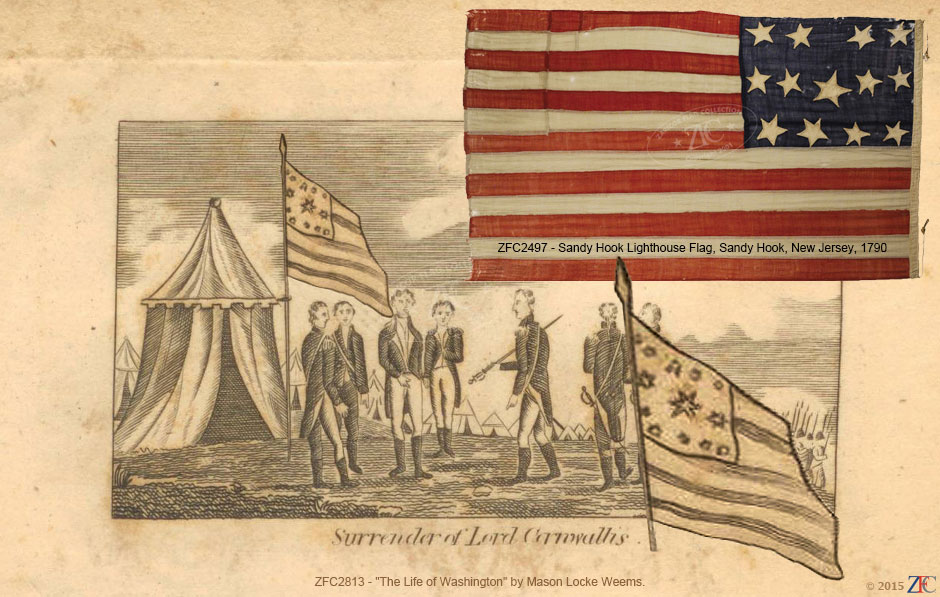
ZFC2497 - 13 Star U.S. Flag, four-five-four star pattern design with a large center star, Early Federal Period.
This wool, 4-5-4 star pattern, 13 Star United States flag, is one of the earliest documented American flags in existence. From the Old Sandy Point Light House, New York in 1790, it was made shortly after the government was formed and flown under the authority of the Department of Treasury's Lighthouse Establishment, one of the federal government's first bureaucracies.
The flag is a sturdy, if crudely made maritime flag, which utilizes twill woven heavy cotton for both the stars and the header; its most startling feature is the large center star in the middle of the center row. The use of a large center star was a fixture in early American flags, but its appearance on a documented, period 13 star flag indicates that this motif has been used on United States flag since the beginning of the Republic.
The Sandy Hook Lighthouse, designed and built in 1764 by Isaac Conro, is located near the very tip of Sandy Hook, New Jersey, and is the oldest working lighthouse in the United States. After the Revolutionary War, a dispute over dominion of the lighthouse broke out between New Jersey and New York. However, Congress resolved the dispute on August 7, 1789 when they gave control of all lighthouses to the federal government. As a result, lighthouses became one of the first civil establishments that needed to be identified as federal rather than state property.
√?¬†
1st Flag Act 1777: 13 Stars, Revolution & Early Federal Period Grouping
√?¬†
| Item Ref | Item Name | Sub-Collection | |
 |
ZFC0604 | U.S. 13 Star Flag - Great Star in Glory. | U.S. 13 Star Flags |
 |
ZFC0707 | U.S. 13 Stars flag - Privateer Minerva. | Mastai - Early American Flags |
 |
ZFC2497 | U.S. 13 Star - Old Sandy Point Lighthouse. | Crow Art Partnership Collection |
 |
ZFC0419 | U.S. 13 stars 4-5-4 pattern Flag, Merchant Ensign. | Guthman / Early American |
 |
ZFC0624 | U.S. 13 Star Flag - Hancock & English. | Mastai - Early American Flags |
 |
ZFC1495 | U.S. 13 Star Flag - early all cotton flag. | U.S. Naval |
 |
ZFC0715 | U.S. 13 Star Flag - Single Ring with Center Star. | Mastai - Early American Flags |
CONFIDENTIALITY NOTICE: This Website, and any contents or web pages attached may contain confidential information, including information that is legally privileged. You are hereby notified that any entry into this site or disclosure, copying, distribution or use of any of the information contained in or attached to this site is strictly prohibited. If you have any knowledge of attempts to enter this site wrongfully, please immediately notify us via e-mail or phone. This system contains privileged and confidential information and is intended for the exclusive use of Zaricor Flag Collection ("ZFC") personnel and our clients. Only authorized ZFC personnel or specifically authorized clients are permitted access to this system. Any unauthorized use of this system is unlawful, and may be subject to civil and/or criminal penalties. All access to this system is monitored and may be used as evidence in court. If you are uncertain of your authorization status please contact us.


